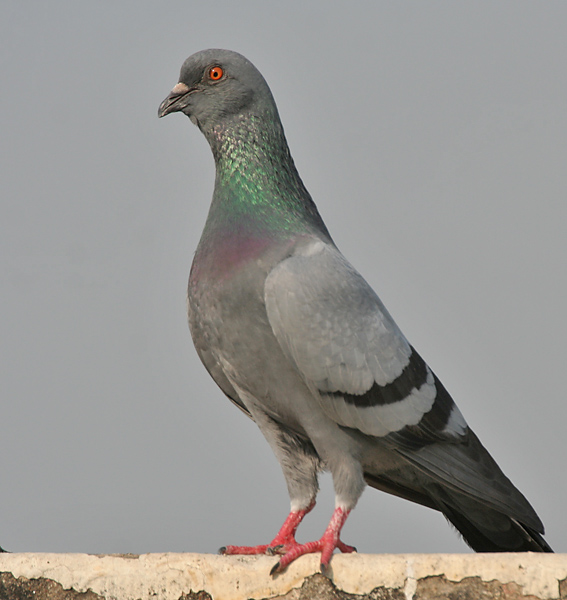Columba livia
Rock Pigeon
Synonym(s):
Class: Aves
Order: Columbiformes
Family: Columbidae

Photographer: J. M. Garg
Source: http://en.wikipedia.org/wiki/File:Blue_Rock_Pigeon_%28Columba_livia%29_in_Kolkata_I_IMG_9762.jpg
Description
Rock pigeons (Columba livia) are commonly seen with gray to blue bodies, iridescent throat feathers, black tips or bands on the wing tips, and black bands on the tip of the tail. There can be extreme variation in the color of rock pigeons to the extreme of birds with a rust red body. The banding pattern of the wing is variable with one or two bands present or sometimes no markings on the entire bird.
Ecological Threat: Due to their preference for disturbed areas, rock pigeons do not have negative effects on native bird species. As a common prey item for endangered falcons, rock pigeons have aided in restoring critical population numbers of falcons in many areas. Rock pigeons are known as common pests in many urban areas and are capable of carrying nematode and cestode parasites (Tetrameres sp., Dispharynx nasuta; Killigrewia delafondi, Skrjabinia bonini, Hymenolepis sp.) and avian lice, but populations do not pose a large ecological threat at this time.
Biology: Male rock pigeons will select a nesting site such as a rain gutter or stairwell, then coo to attract a mate. The female remains in the nest during egg incubation forming a nest made of twigs brought by the male, feces, and eventually shells from hatchlings. Rock pigeons will reuse nests for several years after claiming a nesting site. Clutch size range from 1-3 eggs with a frequency of 1-6 broods per year (decreasing with age). The white eggs incubate for a period of 18 days after-which down covered helpless hatchlings mature in the nest for 25-32 days.
History: The introduction of the rock pigeon along with many other invasive birds from Europe occurred in the early 1600's. Rock pigeons became quickly established in North America with the greatest density of populations found in metropolitan areas.
U.S. Habitat: Rock pigeons can be found in crowded metropolitan areas feeding on discarded food and bird seed. In rural areas, rock pigeons will roost in the eaves of barns or sheds. They can also be found nesting in natural structures such as cliffs, which is considered to be their archetypal habitat.
Distribution
Native Origin: Europe
U.S. Present: The rock pigeon is found throughout the entire U.S. year-round.
Resembles/Alternatives
The rock pigeon is similar to the commonly seen mourning dove (Zenaida macroura), but the rock pigeon is larger and more robust. The rock pigeon is also similar to the native band-tailed pigeon (Patagioenas fasciata), but lacks the white collar found on the dorsal side of band-tailed pigeons.
Management
Natural population control occurs through falcons preying on rock pigeons. To minimize populations in neighborhoods or urban areas, reducing spilled seed and picking up trash can deter pigeons from gathering in large densities. In urban areas rock pigeons are fairly comfortable approaching humans for a source of food, which can be deterred by discouraging feeding a wild pigeon populations.
References
Arieli, Yehuda, Lissa Peltonen, and Jacob Marder. 1988. Reproduction of rock pigeon exposed to extreme ambient temperatures. Comparative Biochemistry and Physiology 90(3): 497-500.
Dunmore, Ralph. 1968. Plumage Polymorphism in a Feral Population of the Rock Pigeon. American Midland Naturalist 79(1): 1-7.
Internet Sources
http://www.allaboutbirds.org/guide/Rock_Pigeon/id
http://birdweb.org/birdweb/bird/rock_pigeon#
 Texas Invasive Species Institute
Texas Invasive Species Institute